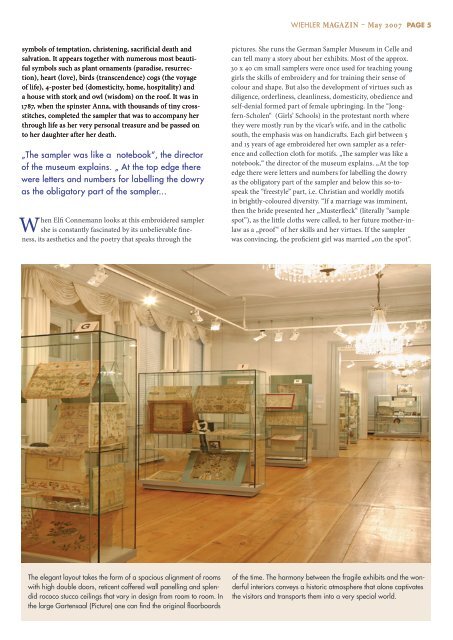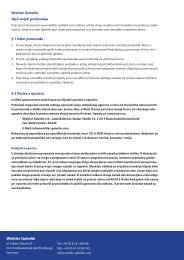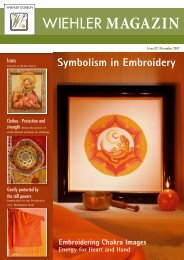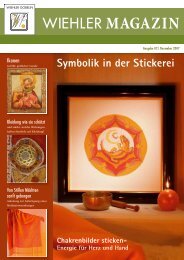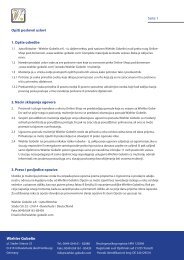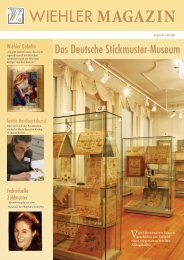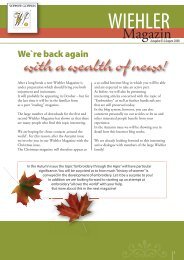Wiehler MAGAZIN - Wiehler Gobelin
Wiehler MAGAZIN - Wiehler Gobelin
Wiehler MAGAZIN - Wiehler Gobelin
Create successful ePaper yourself
Turn your PDF publications into a flip-book with our unique Google optimized e-Paper software.
symbols of temptation, christening, sacrificial death and<br />
salvation. It appears together with numerous most beautiful<br />
symbols such as plant ornaments (paradise, resurrection),<br />
heart (love), birds (transcendence) cogs (the voyage<br />
of life), 4-poster bed (domesticity, home, hospitality) and<br />
a house with stork and owl (wisdom) on the roof. It was in<br />
1787, when the spinster Anna, with thousands of tiny crossstitches,<br />
completed the sampler that was to accompany her<br />
through life as her very personal treasure and be passed on<br />
to her daughter after her death.<br />
„The sampler was like a notebook“, the director<br />
of the museum explains. „ At the top edge there<br />
were letters and numbers for labelling the dowry<br />
as the obligatory part of the sampler...<br />
When Elfi Connemann looks at this embroidered sampler<br />
she is constantly fascinated by its unbelievable fineness,<br />
its aesthetics and the poetry that speaks through the<br />
The elegant layout takes the form of a spacious alignment of rooms<br />
with high double doors, reticent coffered wall panelling and splendid<br />
rococo stucco ceilings that vary in design from room to room. in<br />
the large Gartensaal (Picture) one can find the original floorboards<br />
<strong>Wiehler</strong> <strong>MAGAZIN</strong> – May 2007 Page<br />
pictures. She runs the German Sampler Museum in Celle and<br />
can tell many a story about her exhibits. Most of the approx.<br />
30 x 40 cm small samplers were once used for teaching young<br />
girls the skills of embroidery and for training their sense of<br />
colour and shape. But also the development of virtues such as<br />
diligence, orderliness, cleanliness, domesticity, obedience and<br />
self-denial formed part of female upbringing. In the “Jongfern-Scholen“<br />
(Girls’ Schools) in the protestant north where<br />
they were mostly run by the vicar’s wife, and in the catholic<br />
south, the emphasis was on handicrafts. Each girl between 5<br />
and 15 years of age embroidered her own sampler as a reference<br />
and collection cloth for motifs. „The sampler was like a<br />
notebook,“ the director of the museum explains. „At the top<br />
edge there were letters and numbers for labelling the dowry<br />
as the obligatory part of the sampler and below this so-tospeak<br />
the “freestyle” part, i.e. Christian and worldly motifs<br />
in brightly-coloured diversity. “If a marriage was imminent,<br />
then the bride presented her „Musterfleck“ (literally “sample<br />
spot”), as the little cloths were called, to her future mother-inlaw<br />
as a „proof “ of her skills and her virtues. If the sampler<br />
was convincing, the proficient girl was married „on the spot“.<br />
of the time. The harmony between the fragile exhibits and the wonderful<br />
interiors conveys a historic atmosphere that alone captivates<br />
the visitors and transports them into a very special world.


